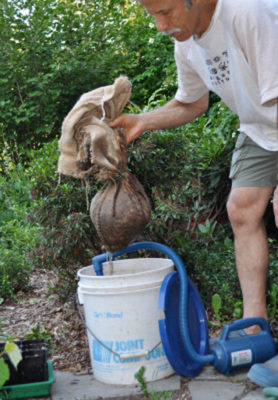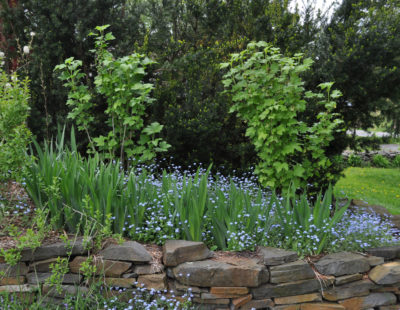COMPOST TEA: SNAKE OIL OR ELIXIR? BLACK CURRANTS…
Tea For Plants?
Has your garden had its tea this morning? Tea is all the rage for plants and soils these days. Compost tea. And not just any old compost tea, but tea you steep in water that’s aerated just like an aquarium.
Compost tea steeped the old way, by hanging a burlap sack of compost in a bucket of water for a few days, was one way to provide a liquid feed to plants. The liquid feed wasn’t particularly rich but did provide a wide range of nutrients that leached from the compost, and was convenient for feeding potted plants.
The new, aerated compost teas are billed as an efficient way to transfer beneficial microorganisms from compost into the soil or onto plant leaves. After all, spraying a little tea is less work than pitchforking tons of compost. In the soil, the little guys can spread their goodness, fighting off plant diseases and generally making plants healthier. Or so goes the logic and the promotional material.
Aerated compost tea (ACT) is big business these days, with people selling compost tea, compost tea brewers, and services for testing compost teas. Compost tea is more than big business; it’s bordering on religion (as anyone who criticizes compost tea soon finds out).
In fact, aerated compost tea is not the panacea it’s trumped up to be. Many independent studies have found the tea to be of no benefit, or even detrimental. Occasionally, human pathogens have been found lurking in compost tea.
In The Interest Of Science
I have a friend who believes in compost tea, so in the interest of science I agreed, on his urging, to try it out. To make sure any lack of efficacy could not be blamed on the tea itself, he sent me some compost, a brewer, and instructions for brewing and application. Interestingly, he told me not to try it out in my vegetable garden, because my garden was “too organic”(!)
Long story short: I applied tea to my lawn and to some vegetables in a relatively poor soil at a local farm, and the result was . . . (drum roll) . . . nothing, nada, rien, zip.
Tea Doesn’t Make Sense
All the buzz about compost tea bypasses the fundamental question of why compost tea would limit plant disease when sprayed on plant leaves? The theory goes that the good microorganisms colonize leaves to displace and/or fight off the bad guys.
Compost tea contains some of the microorganisms from the compost that made the tea. These microorganisms are normally found in soils and, of course, composts. But why, evolutionarily speaking, would these microorganisms provide any benefit on plant leaves, for disease control or any other purpose? Furthermore, these microorganisms evolved in a dark, nutrient and moisture rich environment. Why would they survive on a sunny, dry, nutrient poor leaf? The same goes for soils: If the soil has the right environment for a particular set of microorganisms, they generally are there; apply microorganisms to a soil lacking the needed environment and those microorganisms cannot survive.
Occasional research papers report positive effects of compost tea for thwarting plant diseases. I contend that if you spray just about anything on a plant leaf and measure enough plants closely enough, you’ll turn up some measurable response to the spray. That response might be very transitory and very small, but, with the right equipment or instrumentation, you’ll measure some effect. Whether that effect is of biological or practical significance is another story.
With that, I suggest someone begin a series of experiments to see the effect on plant diseases of spraying — say — milk solutions on plant leaves. Wait! A web search tells me that milk sprays have been tested and are, in fact, effective in controlling plant viruses, powdery mildew, and other diseases. In contrast to compost tea, which provides microorganisms but little of the food they need to survive, milk provides a smorgasbord of nutrients to whatever microorganisms tag along for the ride.
On the basis of the evidence, I’d go with milk rather than tea for my plants. And I’ll take my milk without tea.
Black Currants, Mmmmm
Moving on to something noncontroversial, my first black currants of the season ripened June 26th this year. Come to think of it, black currants may not be noncontroversial. Black currants have a strong, very

Belaruskaja black currants
distinctive flavor, loved by some people, abhorred by others. The flavor starts out refreshingly tart as your teeth break the skin and then becomes sweeter and cooling, with a rich, resiny flavor, as you continue.
I count myself among the lovers of black currants, right up there
with blueberries in my book. Black currants earned a whole chapter in my book, Uncommon Fruits for Every Garden. Although humans are divided on whether or not they enjoy fresh black currants, pretty much everyone loves the fruit concocted into jams and baked goods. They also flavor the liqueur cassis, I’ve used them to flavor beer.
Let’s be clear about the fruit in question. Black currants are not the same fruit as “dried currants.” Those currants are raisins made from dried Black Corinthe grapes, a name which was bastardized to “black currant.”
Black currants are borne on medium-sized bushes whose leaves, when brushed against, emit a strong, also resiny aroma. The leaves are sometimes brewed into tea — for humans, not plants.

